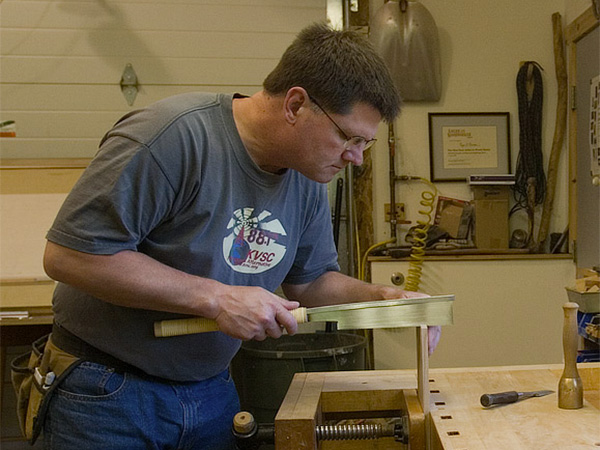
We don’t want you to listen to Ross Peterson. He’s an accomplished furniture maker and furniture designer, and he’s got advice for self-taught woodworkers that we don’t want you to hear. “Don’t make anything from a pattern,” is Ross’s advice. As you can imagine, this advice doesn’t sit well with the editors of Woodworker’s Journal or this eZine. On the other hand, we do like builders to view our plans as a starting point, not necessarily the final word.
Nevertheless, we’re passing his advice on to you because Ross has some important points to make about furniture design and how he approaches the design process. “If you’re interested in developing any design sense, you can’t rely on anyone else to tell you what to do. Take a few chances and see what happens,” says Ross, a professional furniture maker in Hanover, Minnesota.
A quick look at Ross’s designs will convince you he knows something about creating original pieces of furniture. But he didn’t get his eye for design from a school or from emulating any one particular genre of woodworking. He’s completely self-taught both in woodworking and as a designer, learning most of what he knows from books, magazines and other artisans.
Besides not relying on woodworking plans, Ross also strongly recommends going to shows, museums and craft fairs if you want to get a good sense of design. And don’t just look at the wood art, he says. He finds inspiration in a variety of art forms, including ceramics. “I’ve built pieces that were inspired by the form I saw in a hand-thrown piece of pottery,” says Ross.
“Scandiasian Decocraftsman” At first glance, you might think he was influenced heavily by Frank Lloyd Wright, but Ross confesses he knows little about Wright’s work. When asked to describe his style, he calls it “Scandiasian Decocraftsman” because it’s such a mix of Scandinavian, Asian, Art Deco and Craftsman styles of furniture. That’s what happens when you teach yourself woodworking design (and forego using patterns), so be careful out there.
Ross got involved in woodworking as a hobby back in 1986, but wasn’t very serious about it. He finally decided to build himself a professional European workbench in 1990, and that’s when the hobby became something more. He entered a piece in the 1994 Northern Wood Show–the only one he thought was even close to presentable–and won an award. He freely admits that “sometimes you’re your own worst critic–most of the time, really.” That award made him think he could do his brand of woodworking professionally and, in the summer of 1997, he quit his job as an iron worker and went pro.
Now he primarily does commissioned pieces and is part of a woodworker’s cooperative that has a shop in Minneapolis. He’s on his fifth Lacewood Cabinet (above) but rarely does the same piece that often. He begins designing most pieces by looking first at the space that needs to be filled. He will outline that space on paper and then make his ideas fit in that box. Once he’s sketched out the piece of furniture, he makes some guesses about the scale and goes from there. “I guess I just kind of do what my eye tells me,” he says. Sometimes, as with his first Lacewood Cabinet, he gets lucky and it works out on the first try.
If forced to choose, Ross says his favorite wood is soft maple. He says that it has more life in it than hard maple and likes the color, the texture, and how well it polishes up. “I like most woods in their own way. Some of them are kind of nasty to work with, but it’s worth it because of the results you can get,” he says. Wenge, an African wood, is difficult to work with because it’s brittle, it’s full of slivers and is really hard. But, he adds, it’s the only wood that’s truly black (besides ebony), so it’s worth the extra hassle. He always goes with natural wood colors and never uses stain. “I only work with what I can get from the wood,” says Ross.
-Bob Filipczak







